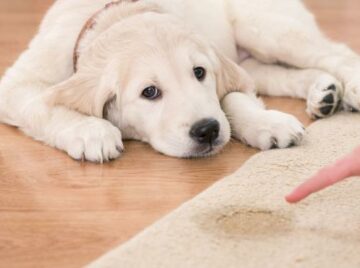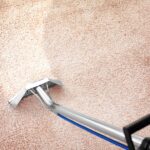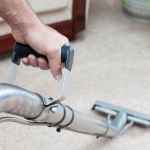Having carpets and owning pets might not seem like the ideal combination, as carpets aren’t as easy to keep clean as hard floor surfaces. Yet, there’s no reason why you can’t enjoy the benefits of being a carpet owner whilst having furry friends at home.
When pets do come onto the scene, however, you’ll probably need to increase or adapt your carpet care, cleaning and maintenance routines compared to before, to keep carpets looking their pristine best. Here are some top carpet care tips that every pet owner needs to know.
Pet hair
One of the biggest issues for carpet owners with pets is that fur can quickly accumulate in a carpet, getting tangled inside carpet fibres. In order to keep on top of fur build up, you’ll probably need to put the hoover on at least three times per week. For stubborn patches of fur that won’t seem to shift from a carpet, try loosening them by applying a mixture of fabric softener and water to the area, allowing it to dry, before running the hoover over it.
There are also various tools such as rollers that you can buy that are effective at getting rid of fur from carpets and furniture.
Bear in mind – prevention is better than cure, so limit the amount of fur that your pet sheds in the first instance by grooming them regularly with a soft brush.
Little accidents
No matter how well-trained a pet is at using the toilet in the right place, it’s inevitable that little accidents are going to occur now and again, especially if your pet is young or a new addition to your home. While it can be disheartening to discover your precious carpet has taken on the role of a toilet, if you take immediate action, no long-term harm needs to be done.
So, what do you do when a pet soils a carpet? First off, soak up as much moisture as possible from the carpet, using an absorbent towel. Take a cup of warm water and mix in several drops of liquid detergent, and then work it into the soiled area. Rinse the area well to remove the cleaning solution.
Pets can often revisit areas of a carpet that they have previously soiled, so even if you think it may be clean, traces of odours can still be left behind that animals can pick up on. Therefore, to prevent any further mishaps, blot the surface with white vinegar mixed with some water, to neutralise any lingering odours. Remove the remaining moisture from the carpet by placing a layer of paper towels on top of each other, weighed down with a book. Sprinkle some bicarbonate of soda onto the area and leave overnight before vacuuming, to further neutralise any odours.
Solids left on carpets, such as faeces or vomit, will also need instant attention, so put some gloves on and remove as much of the solid mess as possible. Some pet owners swear by using a putty knife to press into the area around the mess and then moving the knife in to scoop it up, or you could use a baby wipe to gather the mess up. Once as much of the solids have been removed, it’s key not to press or rub any remaining residues into the carpet. Add some drops of white vinegar to soapy water and pour onto the stained area, leaving it to soak in for 10 minutes or so. Blot the moisture with an absorbent towel and sprinkle the area with baking soda to eliminate traces of odours.
While you might be tempted to clean a carpet using bleach, be cautious. Using bleach on a carpet may damage it, so check that a carpet is bleach cleanable first.
Another thing you might want to think about when dealing with accidents on your carpet, is what you feed your pet. Some foods contain colours, dyes or artificial additives, which can make toileting accidents harder to remove from a carpet, without leaving a stain.
For peace of mind that your carpets are completely fresh and free from traces of stains or odours, a carpet cleaning company for pet owners will have the required know-how and products to assist.
Pest infestations
One of the downsides of owning pets is that they’re prone to fleas, ticks and worms, especially if they spend a lot of time outdoors. While there are many treatments available to keep on top of pest infestations, it’s inevitable that at some point in your pet’s life they’re going to become infected. And this means your carpets might become affected, too.
Frequent vacuuming is key to removing any unwanted pests and their eggs from a carpet, making sure to use the nozzle attachment to tackle corners and baseboards. If your vacuum cleaner is a bagged type, throw the bag away after each use if you suspect pests may be lurking in a carpet.
Insecticide products can be used to spray onto a carpet to remove any remaining fleas etc, but for a more natural solution some people apply a mixture of salt and baking soda to a carpet, which supposedly dehydrates fleas and kills them. Alternatively, a professional carpet cleaning company will know just how to tackle this common problem.
Muddy marks
If your pet has been outdoors, there’s bound to be a time when they’ll bring in mud on their paws, leaving unsightly marks printed across the carpet – these will be especially noticeable in high-traffic areas, such as entrances. Whilst you might be tempted to get to work right away to remove them, the best course of action is to leave them (for the time being) and let them dry. Once the marks have dried, it’s much easier to vacuum them up. Any remaining stains can be tackled with a clean cloth dipped in warm soapy water. Once the stain has been removed, dab the area with cold water and then blot the area to dry.
Prevent carpet marks from mucky paws by cleaning pets down when they come into the house. Keep a towel and a water spray bottle by the door so you don’t forget.
If you want to protect high-traffic areas of a carpet, such as door entrances, you could also invest in a mat or rug to go over that area, which can be easily washed.
Prevent scratching
It’s natural behaviour for cats to scratch, as it helps to sharpen their claws, so you shouldn’t stop them from doing this. However, that’s not to say you should put up with them tearing your beloved carpet (or other furniture) to shreds.
If cats do start exercising their claws on a carpet, remove them from the area instantly and put them next to a scratching post to encourage them to use that instead. If they keep going back to the same area in your carpet, they could be attracted to pheromone scents, so apply some bicarbonate of soda to neutralise any odours that may encourage carpet scratching behaviour.
Carpet choices
Some carpets are easier to maintain if you’ve got pets than others, so if you’re thinking of getting a new carpet, look for pet-friendly options, such as those made from nylon fibres. As well as being highly affordable, nylon is durable and offers good resistance to stains, so that spills and marks are easier to manage.
Carpets that have a saxony cut, ie, long cut fibres are also a good choice for pet households, as animal claws won’t get caught in the soft fibres. Twist carpets are equally suitable if you have pets, as they’re hardwearing. Pet claws are more likely to get caught in loop pile carpets, so avoid these if you want your carpets to stay in good condition.
Professional cleaning
Even without pets, carpets should be professionally cleaned at least once a year, but when furry friends are introduced into the home, carpets will benefit from an expert clean every six months or so. This may need to be done more frequently if pets regularly soil a carpet.
A cleaning company will have the equipment and expertise to remove all traces of dirt and pet residues from deep within a carpet, while also being able to effectively deodorise it, so that odours are eliminated. Professional cleaning is one of the best ways to keep a carpet in the best condition possible, with or without pets, so get in touch with our carpet cleaning London company.







